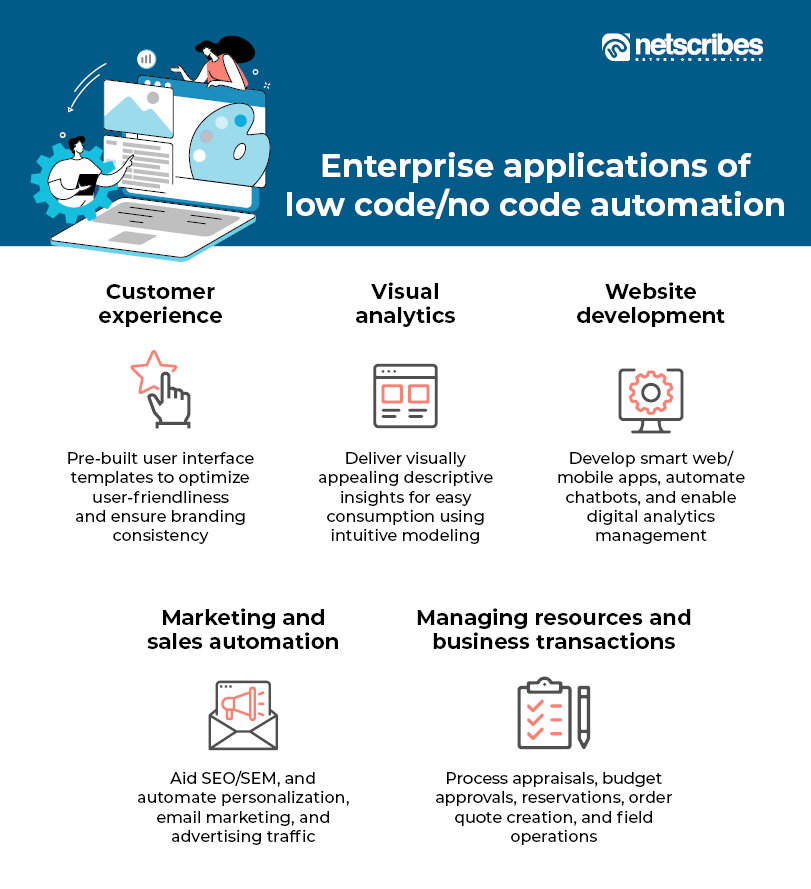Recommended Info For Deciding On Low-Code Platform Recommendations
Recommended Info For Deciding On Low-Code Platform Recommendations
Blog Article
Low-Code App Development Is Faster.
The development of applications using low-code significantly improves development speed because of several key factors: Visual Development Environment:
Drag-and-Drop Interfaces: Low-code platforms provide visual tools for designing applications. Drag-anddrop components enable developers to build apps quickly without writing code.
Many low-code platforms have pre-built templates and components. This lets developers quickly build or prototype applications, without having start from scratch.
Coding needs that are reduced:
Automated Code Generation Low-code platforms automatically create the underlying code based on the visual models designed by the developers. This means that there is less manual coding.
Reusable components: Developers are able to use reusable component across multiple projects, which can reduce the amount of time they're creating and evaluating code.
Collaboration streamlined:
Low-code development platforms are usually equipped with tools such as version control, deployment and testing. This allows seamless collaboration across teams.
Citizen Development Developers, business users and other users can all contribute to application creation through user interfaces that are intuitive. This helps to reduce the bottleneck created by the inaccessibility of skilled developers.
Rapid prototyping and iteration
Rapid Prototyping: Developers design prototypes in a short time to validate ideas and gather feedback. This leads to faster iteration cycles.
Easy Modifications. The visual interface low-code development gives allows users to easily upgrade and modify applications. This speed up the process of improving and refining the application in response to the feedback of users.
Pre-built Integrations:
API Integrations. A lot of low-code platforms have connectors designed for the most well-known APIs and services. This could reduce the time to integrate systems.
Data Integration: Inbuilt tools to integrate data simplify the process of connecting to databases and other sources of data and speeding development.
Scaling, deployment and deployment
One-Click Embedded Deployment: Many low-code platforms offer one-click deployment options, significantly decreasing the amount of time and effort required to deploy apps.
Cloud-based solution: Cloud based low code platforms are capable of handling infrastructure management and scaling. This lets developers concentrate on functionalities, application logic and features, rather than the logistics of deployment.
Overall, the advantage of developing low-code applications in terms of speed lies in the ability of it to automatize and simplify many aspects of the development process, which allows for faster delivery of applications and quicker adaptation to changing requirements. Have a look at the best Low-code Platform for application development for site info including app dev platform, jdbc server, low code development platforms, app modernisation, develop mobile application, develop web application, develop web app, rapid application design, database in azure, application development platforms and more.
Low-Code Application Development Offers Many Benefits In Terms Of Cost-Effectiveness
Low-code applications offer a variety of advantages in terms of cost-effectiveness. Businesses trying to cut costs can benefit from this approach while also delivering high-quality applications. Here are the top benefits: Reduced Development Costs:
Less Coding Required: Low-code platforms minimize the requirement for extensive hand-coding, reducing the amount of time and effort developers have to spend on building applications. This means lower cost of labor.
Fewer Developer Resources: Since low-code development is quicker and simpler, fewer specialized developers are required. The cost of hiring and staffing could be reduced significantly.
Speedier Time to Market
Accelerated development cycle: Visual development tools and pre-built components that are provided by low-code platforms enable rapid application development. This allows companies to bring their products to go to market faster. This can result in quicker revenue growth and better standing in the market.
Rapid prototyping. Through the rapid creation and testing prototypes companies can cut down on time spent development and iterate faster based upon user feedback.
Reduce the cost of maintenance
Simpler maintenance: Low-code platforms, with their standardised components and modular architecture can be maintained more easily. It helps reduce maintenance and support costs.
Automated Patches and Updates: Low-code platforms can manage patching and updating applications automatically. This guarantees that your application remains secure and always up to date with no manual intervention.
Efficient Resource Utilization:
Non-Developer Contributions: Low-code platforms empower businesses and other non-developers to participate in the process of development. This openness of the development process enables companies to tap into the expertise and expertise of a greater number of employees.
IT Departments can Focus on Strategic Initiatives instead of being caught up in routine development tasks IT departments are able to concentrate their energies on strategic initiatives to increase the efficiency and productivity of their departments.
Models of pricing that are scalable:
Subscription-Based Pricing: A lot of low-code platforms offer flexible, subscription-based pricing plans that grow in line with the amount of usage. This allows businesses to match spending to actual requirements and growth while avoiding significant initial costs.
Pay-Assosiated Option: A few platforms offer pay-assosiated alternatives. These options ensure that companies pay only for the resources they use and are beneficial for startups and small business with limited funds.
Reduce the costs of third-party software
Low-code platforms usually come with integrated functions that eliminate the need to purchase extra tools or software. This can save you money on subscriptions and software licensing fees.
Pre-Built Integrations: By integrating popular services and systems You can save time and money, avoiding the requirement to create custom integrations.
Improved ROI
Increased Return On Investment Rapid development and lower expenses with a faster time to marketing can help businesses get greater return on their investment.
Enhanced agility: Businesses can adjust quickly to changes in the market or to customer demands which enables businesses to stay relevant and make the most of new opportunities.
Train for More for
User-Friendly Interfaces: The user-friendly interfaces and user-friendly features of low-code platforms minimize the learning curve, making it less necessary to conduct intensive training.
Accessible resources Low-code platforms often have comprehensive tutorials, training materials, as well as community support which reduces the need for formal instruction.
Collaboration streamlined:
Enhanced Collaboration Tools: The collaboration tools integrated into the software facilitate communication and coordination between the team members. This results in more efficient project development process as well as lower costs.
Unified Development Environment : A unified environment makes work easier and reduces the costs associated with managing various tools and platforms.
In general, applications that use low-code are cost-effective because of their ability to reduce the cost of maintenance and development, to accelerate time-to-market, to optimize resource usage and also to offer flexible pricing. These aspects provide significant financial advantages to companies and make low-code a compelling option for organizations looking to maximize their budgets and achieve robust, scalable, high-quality applications. Check out the best Enterprise application development with Low-code Platform recommendations for site tips including azure sql, push alerts, stored sql procedures, mobile development platforms, microsoft azure sql, low code development platforms, application modernization software, app platforms, develop cross platform mobile app, app modernisation and more.
Benefits Of Low-Code Application Development In Terms Of Customization And The Limitations
Low-code application design is an equilibrative, flexible method that takes into account the limitations of the system and allows for modification. Here are some of the main benefits:Handling limitations:
The Challenge of Overcoming Complexity Barriers
Simplified development: Low code platforms simplify the process by offering templates and pre-built components. This allows faster application deployment, even for complex ones.
Guided Workflows: Many platforms provide guided workflows and wizards that help developers navigate through complicated processes, reducing the chance of making mistakes and guaranteeing consistency.
Scalability solutions:
Scalability is a part of the Low-code platforms often include features that enable scalable architecture. Applications are able to handle higher loads with minimal redevelopment.
Performance Monitoring: The tools that track and optimize performance can help ensure that the applications are effective, even when they grow.
Security and Compliance
Integrated security features Low-code platform come with built-in measures of security such as encryption. Access control that is based on roles and automated compliance check address the most frequent security concerns.
Platforms regularly update their compliance and security measures to ensure that applications are safe from new threats.
Capabilities to Customize:
Extensibility:
Low-code platforms let developers expand functionality beyond what is available by adding custom code.
Developers can add customized modules or plugins to address specific business requirements.
APIs and Integration
API Support: Full API support is available to facilitate seamless integration and connectivity to external systems.
Third Party Services: Low-code platforms usually have pre-built connectors to popular third-party services, which makes it easier to connect and modify applications.
Flexible UI/UX Design:
Customizable User Interfaces: Developers may modify and create user interfaces that are in line with branding and usability specifications to create a custom user experience.
Responsive Web Design: Built-in design responsive capabilities enable applications to be customized depending on the device and screen size.
Customizing Business Logic is easy:
Visual Workflow Builders They allow developers to develop complex processes using little or no programming. They can design workflows and business logic visually.
Conditional Logic and scripting: Platforms permit the use of conditional logic, and custom scripting for handling particular business rules.
Data Management
Custom Data Models Developers have the ability to develop custom data models that are specifically tailored to the specific needs of a business. This means that data handling is customized to each application.
Advanced Data Processor: The integration of sophisticated data processing tools and capabilities permits the customisation of the method by which data is analysed and used in the application.
Balance Customization and Limitations
Frameworks and Standards:
Low-code Platforms Support Industry Best practices and standards: Low code platforms encourage the adherence of industry-standard best practices and standards. This allows for the maintenance of high-quality, secure, and scalable applications.
Governance Frameworks built-in governance frameworks guarantee that customizations do not compromise the integrity, security, or compliance of the application.
Iterative Development and Feedback
Rapid prototyping: The ability to rapidly prototype and test modifications allows developers to iterate based on user feedback, refining the application to meet the needs of users.
Low-code platforms are built to support continual advancement. This permits customizations and improvements as requirements for business change.
User Empowerment
Empowering Citizen Entwicklers by giving non-developers the opportunity to customize their applications through intuitive interfaces and low-code platforms, they increase the number contributors who are able to improve and customize applications.
Support and training: A lot of platforms include extensive training resources and support services that assist users in creating customizations that are effective without compromising the application's performance or stability.
Overall, Low-code application creation gives you a framework that's robust and adaptable enough to handle restrictions while allowing the possibility of extensive customization. This balance lets businesses create and maintain functional apps tailored to their needs while maintaining high standards for quality, security, and the ability to scale.